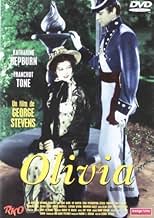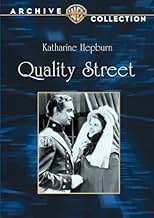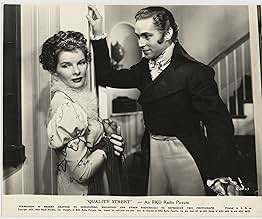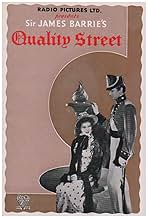CALIFICACIÓN DE IMDb
6.2/10
1.4 k
TU CALIFICACIÓN
Agrega una trama en tu idiomaIn the 1810s, an old maid poses as her own niece in order to teach her onetime beau a lesson.In the 1810s, an old maid poses as her own niece in order to teach her onetime beau a lesson.In the 1810s, an old maid poses as her own niece in order to teach her onetime beau a lesson.
- Dirección
- Guionistas
- Elenco
- Nominado a 1 premio Óscar
- 3 premios ganados y 1 nominación en total
Sherwood Bailey
- William Smith
- (sin créditos)
William Bakewell
- Lt. Spicer
- (sin créditos)
Joan Fontaine
- Charlotte Parratt
- (sin créditos)
Helena Grant
- Fanny Willoughby
- (sin créditos)
Bonita Granville
- Isabella
- (sin créditos)
Carmencita Johnson
- Student
- (sin créditos)
Payne B. Johnson
- School Boy
- (sin créditos)
Darwood Kaye
- Student
- (sin créditos)
Florence Lake
- Henrietta Turnbull
- (sin créditos)
Helen Lynn
- Girl
- (sin créditos)
Lydia McKim
- Schoolgirl
- (sin créditos)
Clifford Severn
- Arthur, a Student
- (sin créditos)
Opiniones destacadas
...Well, this film is chock full of boisterous shyness! Look at us we are so shy! And it gets very annoying in short order. It's about a street in England in 1805 - Quality Street - that has nobody but spinsters living there. No explanation of this is ever given. Every time a man appears all of the curtains part, and the residents all stare. In fact, anytime somebody new appears on the street they all stare.
The residents we are introduced to are ridiculously introverted and repressed, yet they are also passive aggressive and spend their time being nosey about others since they have no real lives of their own. The Throssel sisters are two people living on this street, young Phoebe (Kate Hepburn) and her older sister, Susan (Fay Bainter). Phoebe has some hope of being taken away from all of this when she meets a young physician, Valentine Brown (Franchot Tone), who seems interested in her, but when he comes to her house for a big announcement, it is that he has joined the army to fight Napoleon.
Phoebe declares that Brown is the one she loves, she is not interested in entertaining any other suitors, and then she throws herself into the work of running a school with her sister. Ten years pass and although Phoebe is only 30, she looks much older than that. Thus when Val (Valentine) returns from war, he is visibly shaken by her changed and wilted appearance and seems to recoil. After he leaves, Phoebe shakes down her hair, puts on an ornate gown, and begins to prance around as though she is 20 again. In the process, she seems to transform back into her 20 year old self. It's rather ridiculous - kind of like the 60s movie where a secretary takes off her glasses, shakes down her hair and is suddenly a go-go dancer, but I digress.
The problem is that Val returns suddenly and sees her like this and Phoebe is embarrassed by her behavior, so a servant identifies her as Livy, Phoebe's niece. Val is entranced, and now Phoebe is forced to keep up the ruse of being two people. The complicating factor is that the existence of this relative that nobody ever knew existed is noticed by the nosey neighbors, they don't believe that Livy is a real person, and they set out to prove that Livy and Phoebe are one in the same. Complications ensue.
Besides belaboring the issue of the residents of Quality Street being repressed but nosey, there are just no real likeable characters here. Phoebe should have cleared up this matter from the start but she doesn't, and Val is clueless as to what he means to Phoebe and seems to forget what time and age do to people. It does get pretty amusing in the last act, but it's a tough hard slog to get to that last act.
The residents we are introduced to are ridiculously introverted and repressed, yet they are also passive aggressive and spend their time being nosey about others since they have no real lives of their own. The Throssel sisters are two people living on this street, young Phoebe (Kate Hepburn) and her older sister, Susan (Fay Bainter). Phoebe has some hope of being taken away from all of this when she meets a young physician, Valentine Brown (Franchot Tone), who seems interested in her, but when he comes to her house for a big announcement, it is that he has joined the army to fight Napoleon.
Phoebe declares that Brown is the one she loves, she is not interested in entertaining any other suitors, and then she throws herself into the work of running a school with her sister. Ten years pass and although Phoebe is only 30, she looks much older than that. Thus when Val (Valentine) returns from war, he is visibly shaken by her changed and wilted appearance and seems to recoil. After he leaves, Phoebe shakes down her hair, puts on an ornate gown, and begins to prance around as though she is 20 again. In the process, she seems to transform back into her 20 year old self. It's rather ridiculous - kind of like the 60s movie where a secretary takes off her glasses, shakes down her hair and is suddenly a go-go dancer, but I digress.
The problem is that Val returns suddenly and sees her like this and Phoebe is embarrassed by her behavior, so a servant identifies her as Livy, Phoebe's niece. Val is entranced, and now Phoebe is forced to keep up the ruse of being two people. The complicating factor is that the existence of this relative that nobody ever knew existed is noticed by the nosey neighbors, they don't believe that Livy is a real person, and they set out to prove that Livy and Phoebe are one in the same. Complications ensue.
Besides belaboring the issue of the residents of Quality Street being repressed but nosey, there are just no real likeable characters here. Phoebe should have cleared up this matter from the start but she doesn't, and Val is clueless as to what he means to Phoebe and seems to forget what time and age do to people. It does get pretty amusing in the last act, but it's a tough hard slog to get to that last act.
Delightful comedy of errors. Pheobe (Hepburn) is in love with the dashing Dr. Brown, but alas her love is unrequited. They meet again 10 years later on his return from the Napoleonic Wars. She has wilted under the strain of teaching little children and is self-conscious about her age. On a whim she decides to dress in her former radiant style, and ends up being mistaken by Dr. Brown for Pheobe's niece. They start to court, and from there it's all silly and predictable, but... sparkling dialogue, great acting and wonderful supporting parts (especially the nosy old spinsters at the windows)
For her second time in a James M. Barrie role, Katharine Hepburn starred in a remake of Quality Street. Hepburn had previously played a little Scot's minx in The Little Minister also for RKO.
Barrie did right by her again, she was well cast as one of the Throssel sisters of Great Britain of the Napoleonic Era. She and sister Fay Bainter look like they're doomed to be spinsters. Bainter has resigned herself to that fate, but Hepburn still has hopes.
But when she thinks Franchot Tone might be popping the question, he's only around to tell her he's doing what Admiral Nelson expects of every man, his duty to England. In 1805 he enlists in the army and Hepburn and Bainter go on teaching school.
Ten years go by and when Tone doesn't at first recognize Hepburn when he returns, she thinks her prime has passed. But she'll teach Tone a lesson by impersonating her own made up niece. And what a niece, a naughty flirt who entrances all the young blades returned from the wars and doing a job on Tone's ego as well.
Quality Street has a quality history, it was first performed on Broadway by the immortal Maude Adams in 1901 and then made a silent film in 1927 starring Marion Davies and Conrad Nagel. I can certainly see why William Randolph Hearst thought this a good role for Davies. She could be both a crinolined heroine and also use her comic talents as well. Hepburn also gets to use her full talents playing one role straight and imitating a fictitious person at the same time.
Quality Street got an Oscar nomination for Best Musical Score. If it sounds familiar the theme was recycled later on for the frontier film Rachel And The Stranger. It was even given words that were sung on record by that film's star Robert Mitchum.
And George Stevens after doing Alice Adams with Hepburn was assigned this one as well. He'd do even better the third and last time he worked with Hepburn in Woman Of The Year.
Quality Street is a good film, but I'm sure that Depression Era audiences found a Victorian Era comedy a bit dated.
Barrie did right by her again, she was well cast as one of the Throssel sisters of Great Britain of the Napoleonic Era. She and sister Fay Bainter look like they're doomed to be spinsters. Bainter has resigned herself to that fate, but Hepburn still has hopes.
But when she thinks Franchot Tone might be popping the question, he's only around to tell her he's doing what Admiral Nelson expects of every man, his duty to England. In 1805 he enlists in the army and Hepburn and Bainter go on teaching school.
Ten years go by and when Tone doesn't at first recognize Hepburn when he returns, she thinks her prime has passed. But she'll teach Tone a lesson by impersonating her own made up niece. And what a niece, a naughty flirt who entrances all the young blades returned from the wars and doing a job on Tone's ego as well.
Quality Street has a quality history, it was first performed on Broadway by the immortal Maude Adams in 1901 and then made a silent film in 1927 starring Marion Davies and Conrad Nagel. I can certainly see why William Randolph Hearst thought this a good role for Davies. She could be both a crinolined heroine and also use her comic talents as well. Hepburn also gets to use her full talents playing one role straight and imitating a fictitious person at the same time.
Quality Street got an Oscar nomination for Best Musical Score. If it sounds familiar the theme was recycled later on for the frontier film Rachel And The Stranger. It was even given words that were sung on record by that film's star Robert Mitchum.
And George Stevens after doing Alice Adams with Hepburn was assigned this one as well. He'd do even better the third and last time he worked with Hepburn in Woman Of The Year.
Quality Street is a good film, but I'm sure that Depression Era audiences found a Victorian Era comedy a bit dated.
Quality Street is a contrived romance, with a small cast, on a set that looks like a play stage, with few visual impacts and in B&W. So, why did we enjoy it so much? The cast, down to the overplayed smaller parts, all does a great job. The ensemble cast brings spirit to even the small parts, the dialogue is clever, and the asides and glances make it fun. We particularly enjoyed the set and period behaviors as great insights on life in the early 19th century. Hollywood did a great job in establishing this period essence through effective use of hints and props. If you like Hepburn, you will enjoy this moral story, with feminine strength in an unforgiving society. Worth a relook!
On Quality Street, women occupy their time by either witnessing or passing gossip about their friends and neighbors. Whenever there's a gentleman caller, all the neighbors peer out their windows and stare, taking note of how he was dressed, if he brought flowers, and how long he stayed. What else is there to do in 1805?
Katharine Hepburn and her old maid sister Fay Bainter live on Quality Street, and while they primarily socialize with other old maids and gossipers in town, Kate has one particular friend she treasures: the dashing Franchot Tone. She's known Franchot for a year, and when she thinks he's going to propose, the rumor gets spread all over town. It turns out he enlisted in the army instead, and Kate feels humiliated. Ten years later, Franchot comes home from the war. He's a little gray at the temples, and Kate is no longer the blushing beauty he remembers. Can they fall in love again or is it too late?
While it has an intriguing premise, the rest of the film is pretty silly. In order to get him back, Kate throws caution to the wind and acts like a harlot with all the other men in town, and her mischief-making gets a little long in the tooth after a few scenes. It is great fun to see Kate all dolled up, though. She's more beautiful than she's ever looked in her movies, and her flirtations are charming and sweet. I'm fans of both Kate and Franchot, but Fay Bainter was my favorite character in the film. She was unselfish and a wonderful sister, and I wish she'd taken some screen time away from Kate's silliness.
Katharine Hepburn and her old maid sister Fay Bainter live on Quality Street, and while they primarily socialize with other old maids and gossipers in town, Kate has one particular friend she treasures: the dashing Franchot Tone. She's known Franchot for a year, and when she thinks he's going to propose, the rumor gets spread all over town. It turns out he enlisted in the army instead, and Kate feels humiliated. Ten years later, Franchot comes home from the war. He's a little gray at the temples, and Kate is no longer the blushing beauty he remembers. Can they fall in love again or is it too late?
While it has an intriguing premise, the rest of the film is pretty silly. In order to get him back, Kate throws caution to the wind and acts like a harlot with all the other men in town, and her mischief-making gets a little long in the tooth after a few scenes. It is great fun to see Kate all dolled up, though. She's more beautiful than she's ever looked in her movies, and her flirtations are charming and sweet. I'm fans of both Kate and Franchot, but Fay Bainter was my favorite character in the film. She was unselfish and a wonderful sister, and I wish she'd taken some screen time away from Kate's silliness.
¿Sabías que…?
- TriviaThe Nestle produced chocolates "Quality Street" were named after J. M Barrie's play by their original manufacturer Mackintosh in 1936.
- ErroresWhen Phoebe and Susan are talking about Mr. B., Phoebe is on a chair and Susan is sitting on a sofa a certain distance near a bonnet. But on the following cuts, Susan's sitting position keeps changing so that she is gets closer and closer to the bonnet.
- Citas
Mary Willoughby: [Goes to the window and looks out] It's that impertinent recruiting sergeant. I passed him on the street yesterday. He closed one of his eyes at me, then quickly opened it again.
[She demonstrates to the other ladies in the room]
Mary Willoughby: I knew what he meant.
[She looks out again and sees the recruiting officer wink at her. She quickly closes the window curtain]
- Créditos curiososOpening card:
1805 England Quality Street Where a gentleman passerby is an event.
- ConexionesFeatured in George Stevens: A Filmmaker's Journey (1984)
Selecciones populares
Inicia sesión para calificar y agrega a la lista de videos para obtener recomendaciones personalizadas
- How long is Quality Street?Con tecnología de Alexa
Detalles
- Tiempo de ejecución
- 1h 23min(83 min)
- Color
- Relación de aspecto
- 1.37 : 1
Contribuir a esta página
Sugiere una edición o agrega el contenido que falta

































